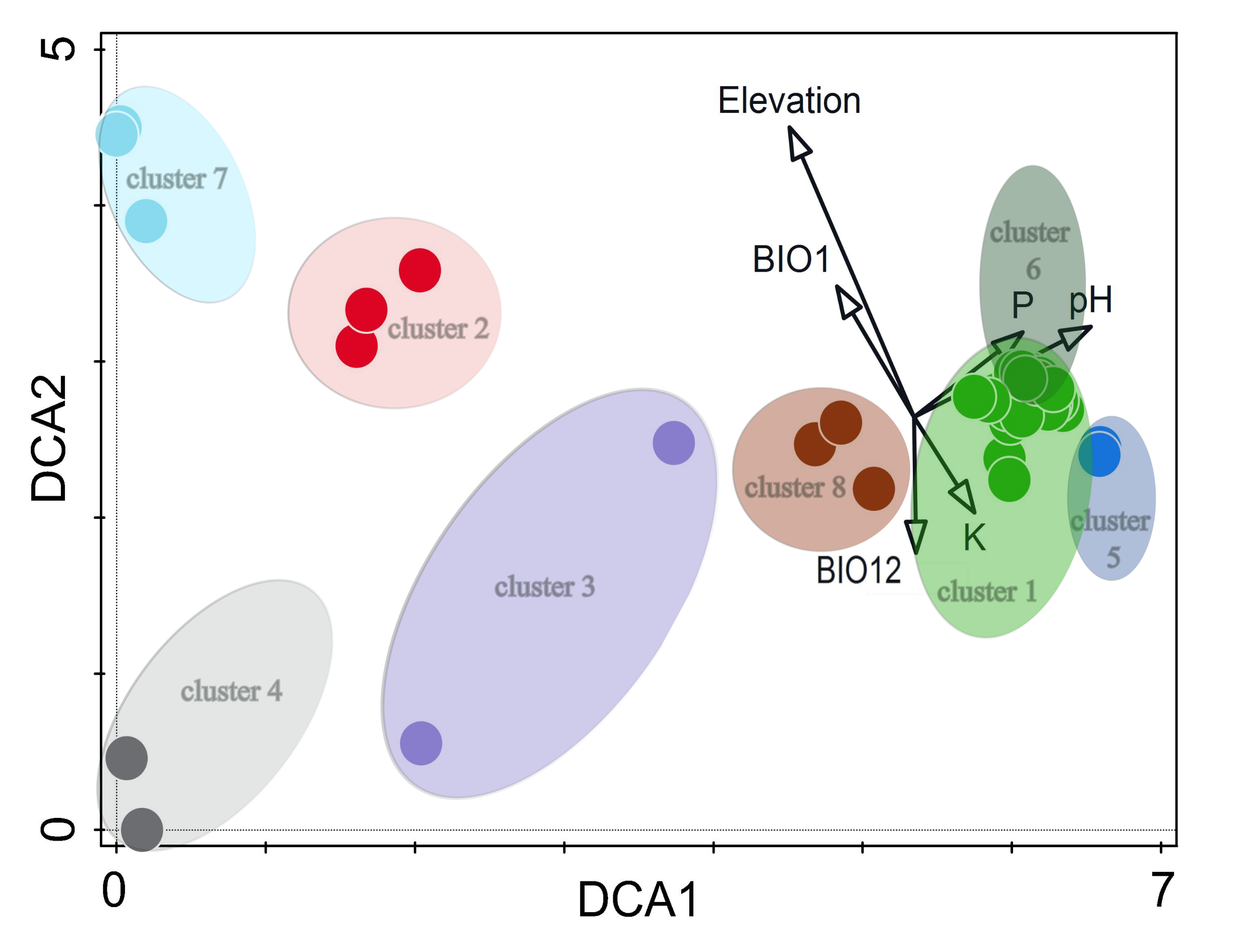Wide habitat preference found in a rare, regional endemic species: Iris brandzae Prodán (Iridaceae Juss., subgenus Limniris, series Spuriae) in Romania
DOI:
https://doi.org/10.2478/hacq-2023-0009Keywords:
Iris Isintenisii subsp. brandzae, habitats, endangered, slope, phytocoenological relevés, floristic compositionAbstract
Iris brandzae is one of the most threatened plant species in Romania. The current distribution of this species is very fragmented, and the population size has been reduced in the last 30 years. Information on the habitat preferences of the species has not been summarized yet. In this context, this study aimed to identify the habitat preferences of the species I. brandzae in Romania. The study was carried out in the NE (Moldova) and SE (Muntenia) regions of Romania. For the vegetation analysis, a total of 46 relevés were used. To classify the vegetation, we applied the hierarchical agglomerative clustering method, using the ß-flexible algorithm with ß = -0.25 and the Bray-Curtis dissimilarity. The data were represented as mean percentage values, according to the the Braun-Blanquet scale . Relationships between floristic composition and environmental variables were analyzed with Detrended Correspondence Analysis (DCA) and Canonical Correspondence Analysis (CCA) . The vegetation analysis showed that I. brandzae grows in xerophilous, mesophilous and halophilous grasslands and ash-alpine alluvial forests. The species occurs in the communities of the Stipion lessingianae alliance, of the Festucetalia valesiacae order, mainly. The results of the CCA analysis indicate that the variation of the floristic composition of I. brandzae is influenced by the annual mean temperature (BIO1).
Downloads
References
Ali, S.I. & Mathew, B. (2008). Iris in Flora of Pakistan, efloras, published on the Internet http://www.efloras.org [accessed 2024 January 05]. Missouri Botanical Garden, St. Louis, MO & Harvard University Herbaria, Cambridge, MA.
Aukhadieva, E., Kalashnik, N. & Ishbirdin, A. (2021). Discussion of some taxonomy issues of species of the genus Iris L. based on biomorphological and karyological characteristics. In E3S Web of Conferences. EDP Sciences, 254, 06008.
Ballabio, C., Lugato, E., Fernández-Ugalde, O......& Panagos, P. (2019). Mapping LUCAS topsoil chemical properties at European scale using Gaussian process regression. Geoderma, 355, 113912.
Bi, X., Li, B., Zhang, L., Nan, B., Zhang, X. & Yang, Z. (2020). Response of grassland productivity to climate change and anthropogenic activities in arid regions of Central Asia. Peer J, 8, e9797.
Borza, A. & Boşcaiu, N. (1965). Introducere în studiul covorului vegetal (Introduction to the study of the vegetation carpet) [in Romanian]. Academia Republicii Populare Române.
Bouxin, G. (2005). Ginkgo, a multivariate analysis package. Journal of Vegetation Science, 16, 355–359.
Braun-Blanquet, J. (1964). Pflanzensoziologie. Grundzüge der Vegetationskunde. Springer.
British Iris Society (1997). A Guide to Species Irises: Their Identification and Cultivation. Cambridge University Press. p. 255.
Cassidy, G.E. & Linnegar, S. (1987). Growing Irises. Bromley: Christopher Helm. 68, 142.
Channell, R. (2004). The conservation value of peripheral populations: the supporting science. In Proceedings of the species at risk 2004 pathways to recovery conference. Victoria, British Columbia, Canada, pp. 1-17.
Chifu, T., Irimia, I. & Zamfirescu, O. (2014). Festuco-Brometea. In: Chifu, T. (Ed.). Diversitatea fitosociologică a vegetației României. Vol. II. Vegetația erbacee antropizată. Tom 1. Vegetația pajiștilor (Festuco-Brometea. In: Chifu T. The phytosociological diversity of Romania's vegetation. Vol. II. Anthropogenic herbaceous vegetation. Part 1. Meadow vegetation) [in Romanian]. Institutul European, Iași, pp. 113–397.
Chifu, T., Mânzu, C. & Zamfirescu, O. (2006). Flora şi vegetaţia Moldovei (Flora and vegetation of Moldova) [in Romanian]. Universitatea Al. I. Cuza.
Chirilă, S. D., Cara, I.G. & Motrescu, I. (2022). Habitat preference of the endangered species Crambe tataria (Brassicaceae) from Romania. Tuexenia, 42, 275–296.
Chirilă, S.D. (2024). Analiza eco-cenotică și structura genetică a populațiilor de Crambe tataria Sebeók din România (Eco-cenotic analysis and genetic structure of Crambe tataria Sebeók populations in Romania) [in Romanian]. Presa Universitară Clujeană, pp. 272.
Chytrý, M., Tichý, L., Hennekens, S.M. & Schaminée, J.H.J. (2020). EUNIS Habitat Classification: expert system, characteristic species combinations and distribution maps of European habitats. Applied Vegetation Science, 23, 648–675.
Coldea, G., Indreica, A. & Oprea, A. (2015). Les associations végétales de Roumanie. 3-Les associations forestières et arbustives (Romanian plant associations. Forest and shrub associations) [in French]. Presa Universitarǎ Clujeanǎ, pp. 281.
Coldea, G., Oprea, A., Sârbu, I., Sîrbu, C. & Ștefan, N. (2012). Les associations végétales de Roumanie. Tome 2: Les associations anthropogénes (Romanian plant associations. Volume 2: Anthropogenic associations) [in French]. Presa Universitară Clujeană, pp. 482.
De Cáceres, M. & Legendre, P. (2009). Associations between species and groups of sites: indices and statistical inference. Ecology, 90, 3566–3574.
Derevenko, T. (2010). Partes Horti botanici ChNU nuncupati. Yu Fedkovich in conservanda floristica diversitate Bukovina. In Conservation of plant diversity, pp. 310-315.
Dihoru, G. & Negrean, G. (2009). Cartea roşie a plantelor vasculare din România (Red book of vascular plants from Romania) [in Romanian]. Academia Română, p. 290.
Dorofeeva, M.M. & Zhurbenko, P.M. (2020). Comparative study of ovule structure and development in some species of Iris subgenus Limniris (Iridaceae). Botanicheskij Zhurnal, 105(1), 15-31.
EEA (2023). Iris sintenisii subsp. brandzae (Prodàn) D.A.Webb & Chater. Data from: https://eunis.eea.europa.eu/species/186816. [accessed 2023 October 16].
Erdős, L., Ambarlı, D., Anenkhonov, O.A., Bátori, Z...... & Török, P. (2018). The edge of two worlds: A new review and synthesis on Eurasian forest-steppes. Applied Vegetation Science, 21, 345–362.
EURO+MED (2023). Euro+Med PlantBase – the information resource for Euro-Mediterranean plant diversity. Data from: http://ww2.bgbm.org/EuroPlusMed [accessed 2023 October 16].
Fedchenko, B.A. & Vvedenskii, A.I. (1935). Iris in Komarov, V.L. (edit.) Flora of the USSR 4, Leningrad.
Fedorov, A. & T︠s︡velëv, N.N. (2001). Flora of Russia 4. CRC Press.
Fick, S.E. & Hijmans, R.J. (2017). Worldclim 2: New 1-km spatial resolution climate surfaces for global land areas. International Journal of Climatology, 37, 14.
Grințescu, I., Nyarady, E.I., Paucă, A., Prodan, I., Șerbănescu, I. & Zahariadi, C. (1966). Iris brandzae, 500 p. In: Săvulescu, T. (1966). Flora Republicii Socialiste România. Academiei Republicii Socialiste România. p. 868.
Hensen, I., Oberprieler, C. & Wesche, K. (2005). Genetic structure, population size, and seed production of Pulsatilla vulgaris Mill. (Ranunculaceae) in Central Germany. Flora-Morphology, Distribution, Functional Ecology of Plants, 200(1), 3-14.
ISO 11263 (1994). Determination of phosphorus - Spectrometric determination of phosphorus soluble in sodium hydrogen carbonate solution. Data from: https://www.iso.org/standard/19241.html. [accessed 2023 October 11].
Mathew, B. (1984). Iris in Davis, P.H. (edit.) Flora of Turkey 8, Edinburgh University Press.
Mânzu, C.C., Irimia, I., Cîșlariu, A.G. & Chinan, V.C. (2020). Chorological data for some rare plant species from ROSCI0222 Sărăturile Jijia Inferioară-Prut and ROSPA0042 Eleșteele Jijiei și Miletinului (Iași County). Acta Horti Botanici Bucurestiensis, 46, 35-54.
Meusel, H., Jäger, E. & Weinert, E. (1965). Vergleichende Chorologie der zentraleuropäischen Flora. Vol. 1. Fischer, Jena (Verbreitungskarte).
Mititelu, D., Ștefan, N. & Ciupercă, Gh. (1979-1980). Flora și vegetația rezervației „Pâclele” cu vulcani noroioși (Jud. Buzău) (Flora and vegetation of the reserve "Pâclele" with mud volcanoes) [in Romanian], pp. 99-120.
Mucina, L., Bültmann, H., Dierßen, K.......... & Tichý, L. (2016). Vegetation of Europe: hierarchical floristic classification system of vascular plant, bryophyte, lichen and algal communities. Applied Vegetation Science, 19, 3–264.
O’Grady, J.J., Reed, D.H...... & Frankham, R. (2004). What are the best correlates of predicted extinction risk? Biological Conservation, 118, 513–520.
Oltean, M., Negrean, G., Popescu, A.... & Mihăilescu, S. (1994). Lista roşie a plantelor superioare din România (Red list of higher plants from Romania) [in Romanian]: Studii, sinteze, documentaţii de ecologie. 1. Academia Română, Institutul de Biologie Bucureşti, pp. 1-52.
Oprea, A. (2005). Lista critică a plantelor vasculare din România (Critical list of vascular plants from Romania) [in Romanian]. Univ. “Alexandru Ioan Cuza”, Iaşi, pp. 668.
Popescu, I.E. (2013). Unicitatea patrimoniului natural din Rezervaţia de fâneţe seculare de la Valea lui David Iaşi (The uniqueness of the natural heritage of the Secular Hay Reserve from Valea lui David Iaşi) [in Romanian]. Mnemosyne, 4, 7-36.
QGIS Development Team (2022). QGIS version 3.28. Data from: https://qgis.org, [accessed 2023 October 14].
Rand, W.M. (1971). Objective criteria for the evaluation of clustering methods. Journal of the American Statistical Association, 66 (336), 846–850.
Rodionenko, G.I. (2005). On the independence of the genus Limniris (Iridaceae). Botanicheskij Zhurnal, 92(4), 547-554 [in Russian].
Rodionenko, G.I. (2009). A new system of the genus Iris (Iridaceae). Botanicheskij Zhurnal, 94(3), 423-435 [in Russian].
Roger, P. & Martyn, R. (1991). Perennials Vol. 1. Pan Books Ltd. p. 216.
Rousseeuw, P.J. (1987). Silhouettes: a Graphical Aid to the Interpretation and Validation of Cluster Analysis. Computational and Applied Mathematics, 20, 53–65.
Sîrbu, C., Oprea, A. & Peregrym, M. (2019). New data about Fritillaria meleagroides in Romania. Journal of Plant Development, 26, 123-135.
SR EN ISO 10390 (2022). Soil, treated biowaste and sludge. Determination of pH. Data from: https://standards.iteh.ai/catalog/standards/cen/35c1e689-fbc3-4bd2-a9e7-7162f61ae30b/en-iso-10390-2022. [accessed 2023 October 14].
SRTM Data (2023). SRTM 90m Digital Elevation Data. Data from: https://srtm.csi.cgiar.org/srtmdata/. [accessed 2023 October 14].
Szczecińska, M., Sramko, G., Wołosz, K. & Sawicki, J. (2016). Genetic diversity and population structure of the rare and endangered plant species Pulsatilla patens (L.) Mill in East Central Europe. PloS One, 11(3), e0151730.
ter Braak, C.J.F. & Šmilauer, P. (2018). Canoco reference manual and user's guide: Software for ordination (version 5.10). Biometris, Wageningen University & Research.
Tichý, L. (2002). JUICE, software for vegetation classification. Journal of Vegetation Science, 13, 451–453.
Tutin, T.G., Heywood, V.H., Burges, N.A..... & Richardson, O.I.B.K. (1980). Flora Europaea. Volume 5: Alismataceae to Orchidaceae (Monocotyledones).
Vassilev, K., Ruprecht, E., Alexiu, V......... & Dengler, J. (2018). The Romanian Grassland Database (RGD): historical background, current status and future perspectives. Phytocoenologia, 48, 91–100.
Văduva, I. (2008). Clima României (Climate of Romania) [in Romanian]. Fundația România de Mâine.
Volutsa, O.D. (2011). Iris brandzae Prodán (Iridaceae) u flori Chernivec'koi' oblasti. Aktual'ni problemy botaniky ta ekologii'. (In Ukrainian).
Wheeler, A.S. & Wilson, C.A. (2014). Exploring phylogenetic relationships within a broadly distributed northern hemisphere group of semi-aquatic Iris species (Iridaceae). Systematic Botany, 34(2), 277-284.
Wilson, C.A. (2004). Phylogeny of Iris based on chloroplast matK gene and trnK intron sequence data. Molecular Phylogenetics and Evolution, 33, 402–412.
Wilson, C.A. (2006). Patterns of evolution in characters that define Iris subgenera and sections. Aliso, 22, 425-433.
Wilson, C.A. (2009). Phylogenetic relationships among the recognized series in Iris section Limniris. Systematic Botany, 34, 277-284.
Wilson, C.A. (2011). Subgeneric classification in Iris re-examined using chloroplastsequence data. Taxon, 60, 27–35.

Downloads
Published
How to Cite
Issue
Section
License
Copyright (c) 2024 ZRC-SAZU

This work is licensed under a Creative Commons Attribution-NonCommercial-NoDerivatives 4.0 International License.
Authors guarantee that the work is their own original creation and does not infringe any statutory or common-law copyright or any proprietary right of any third party. In case of claims by third parties, authors commit their self to defend the interests of the publisher, and shall cover any potential costs.
More in: Submission chapter












